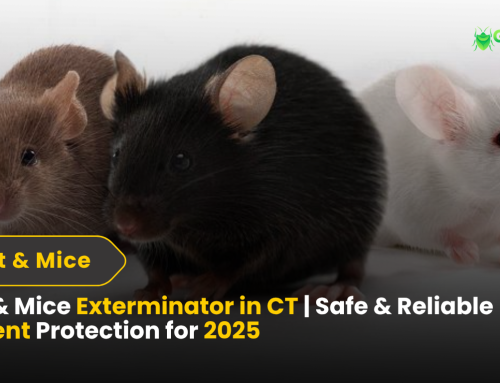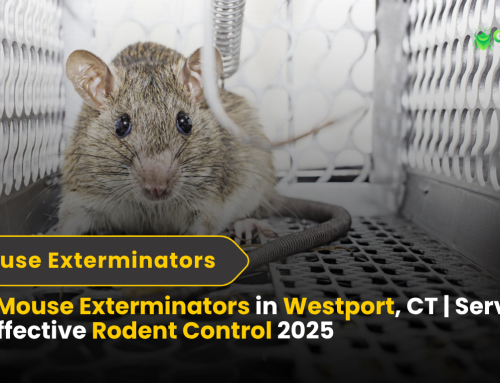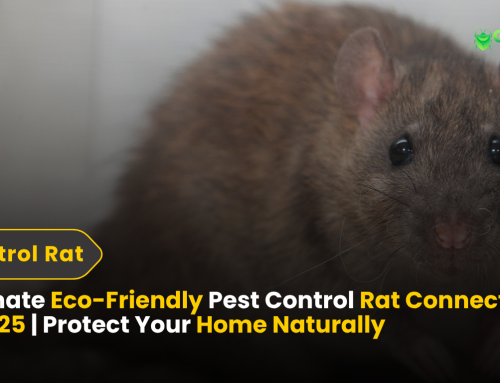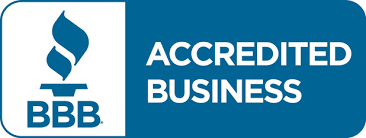How to Control Cockroaches in Connecticut in 2025 | Expert Solutions for Removal Cockroaches
If you’ve spotted a scuttling, dark shape disappear under your refrigerator or found suspicious droppings in a kitchen cabinet, you’re not alone. Cockroaches are a pervasive and deeply unsettling problem for homeowners and business owners across the Nutmeg State. Connecticut’s unique blend of humid summers and cozy, heated winters creates a year-round paradise for these resilient pests. The battle against them is constant, but it is one you can win.
At Green Pest Management, we have dedicated our expertise to mastering the art and science of how to control cockroaches in Connecticut. We serve communities from Greenwich to Westport, helping them reclaim their spaces from these unwelcome invaders safely, effectively, and with a deep commitment to eco-friendly practices.
This definitive guide is more than just a list of tips; it’s a deep dive into the biology, behavior, and proven control strategies for cockroaches in our region. Whether you’re facing a few stray roaches or a full-blown infestation, the following chapters will equip you with the knowledge you need to take back control.
Why Cockroaches Are a Persistent Problem in Connecticut
To understand how to control cockroaches in Connecticut, one must first understand why they find our state so appealing. It’s not a coincidence; it’s a matter of perfect environmental alignment.
The Connecticut Climate Cocktail:
Our summers are characterized by significant humidity, providing the moisture cockroaches need to thrive. They absorb ambient moisture through their skin and are frequently found near leaky pipes, damp basements, and condensation-prone areas. As winter sets in, these cold-blooded pests don’t simply die off; they follow the warmth. They migrate indoors, seeking refuge in our heated homes, restaurants, and commercial buildings. The network of older, charming homes throughout Fairfield County and beyond often comes with tiny cracks, gaps in foundations, and aging plumbing—creating an ideal landscape for cockroach habitation.
The Most Common Culprits: Know Your Enemy
Not all roaches are the same. Effective control hinges on correctly identifying the species you’re dealing with, as their habits and preferred habitats differ.
| Species | Appearance | Typical Hiding Spots | Behavior & Why They’re a Problem |
|---|---|---|---|
| German Cockroach | Small (½-⅝ inch), light brown with two dark, parallel stripes running from the head to the wings. | Kitchens, bathrooms, behind appliances, inside cabinets and drawers. Prefers warmth and moisture. | This is the most common and problematic indoor species. They are prolific breeders, with a single female producing up to 30,000 offspring in a year. They are the primary pest in multi-unit housing and restaurants. |
| American Cockroach | Large (1½ inches), reddish-brown with a yellowish figure-8 pattern on the back of its head. | Basements, crawl spaces, sewers, drains, and in commercial buildings. Often called “sewer roaches.” | While they prefer damp, decaying organic matter, they will venture into homes for food and water. They are strong fliers and can spread bacteria from unsanitary areas into human spaces. |
| Oriental Cockroach | Medium-sized (1 inch), glossy dark brown or black. | Damp areas like basements, floor drains, under sinks, and under mulch or leaf litter. Thrives in cool, moist spaces. | Often called “water bugs,” they are slower moving and can tolerate cooler temperatures. Their strong, unpleasant odor is a telltale sign of a significant infestation. |
Early Warning Signs: Identifying a Cockroach Infestation
Acting early is the single most important factor in successful cockroach control. Waiting until you see a roach in broad daylight often means the infestation is already substantial. Here’s what to look for long before that happens.
1. Droppings: Resembling ground coffee or black pepper, these tiny specks are a primary indicator. You’ll find them in corners of cabinets, on top of shelves, along baseboards, and inside drawers.
2. Egg Casings (Oothecae): These are tan, brown, or dark-colored capsules, often ridged. German roach casings are small (about ¼ inch) and carried by the female until just before hatching, while American roach casings are larger and glued to surfaces in hidden areas.
3. Musty Odor: A large, established colony produces a pheromone that creates a distinct, oily, and musty smell. This odor can permeate food and surfaces.
4. Smear Marks: In areas with high moisture, roaches will leave dark, irregular smear marks on walls and floors as they travel.
5. Shed Skins: As nymphs (young roaches) grow, they molt 5-7 times, leaving behind translucent, hollow replicas of themselves.
6. Property Damage: Roaches will feed on anything organic, including the glue on stamps, book bindings, and cardboard boxes.
If you notice any of these signs, it is time to act decisively. Cockroaches multiply at an alarming rate, and delaying treatment can turn a manageable problem into a deeply entrenched infestation.
A Comprehensive Step-by-Step Plan on How to Control Cockroaches in Connecticut
This multi-pronged approach combines professional-grade strategy with diligent home maintenance. Learning how to control cockroaches in Connecticut is a process, not a single action.
Step 1: The Thorough Inspection – Locate the Source
You cannot defeat an enemy you cannot find. Before any bait is laid or sealant is applied, you must play detective.
-
Tools of the Trade: A high-powered flashlight, a mirror for looking behind appliances, and a probing tool (like a screwdriver) are essential.
-
Key Inspection Areas:
-
Kitchen: Pull out the refrigerator, stove, and dishwasher. Inspect the voids underneath and behind them. Check all cabinet hinges, corners, and plumbing entry points under the sink.
-
Bathroom: Look under sinks, around the base of toilets, and in bathroom vanities. Check for gaps around pipes.
-
Utility Areas: Laundry rooms, basements, and crawl spaces are hotspots. Check around sump pumps, floor drains, and water heaters.
-
General Living Areas: Examine baseboards, electrical outlets, picture frames, and the areas behind furniture.
-
🔍 Pro Tip: Conduct your inspection at night with the lights off, using only your flashlight. Roaches are nocturnal, and this is when you’re most likely to see active movement.
If your inspection reveals activity in multiple, hard-to-reach areas, the most effective and time-efficient solution is to call a professional. At Green Pest Management, our trained technicians know exactly where to look and how to assess the true scope of the problem.
Schedule a professional cockroach inspection with Green Pest Management →
Step 2: Sanitation – Eliminate the Attractants
Sanitation is the non-negotiable foundation of any successful plan for how to control cockroaches in Connecticut. It makes your property less hospitable and increases the effectiveness of other control methods. Remember: roaches need food, water, and shelter. Deny them these.
-
Food Source Elimination:
-
Store all food, including pet food, in airtight glass or plastic containers. Do not leave pet food out overnight.
-
Clean all countertops, tables, and stovetops immediately after eating or cooking.
-
Sweep and vacuum floors regularly, paying close attention to kitchen areas.
-
Rinse all cans and bottles before recycling.
-
Empty trash cans daily and use bins with tight-fitting lids.
-
-
Water Source Elimination:
-
Fix any and all leaky faucets and pipes.
-
Do not let water stand in sinks or basins overnight.
-
In the bathroom, wipe down showers and tubs after use to eliminate puddles.
-
Use dehumidifiers in damp basements and crawl spaces to reduce ambient moisture.
-
Sanitation is not a one-time event; it is an ongoing lifestyle change that is crucial for long-term prevention.
Step 3: Exclusion – Seal Them Out
A critical component of how to control cockroaches in Connecticut is preventing them from entering in the first place. Roaches are masters of infiltration, capable of squeezing through cracks as thin as a dime.
-
Caulk is Your Best Friend: Use a high-quality silicone or silicone-latex caulk to seal:
-
Cracks and gaps in baseboards, walls, and cabinetry.
-
Gaps around pipes, wires, and conduits entering from the outside.
-
Spaces around window and door frames.
-
-
Other Exclusion Tactics:
-
Install door sweeps on all exterior doors.
-
Seal gaps around dryer vents and utility lines.
-
Use steel wool or copper mesh to plug larger holes, as roaches cannot chew through it.
-
Ensure window and door screens are intact.
-
For multi-unit buildings, common in cities like Stamford, this step is even more critical, as roaches can travel between apartments through shared walls and utility conduits.
Step 4: Targeted Treatment – Baits, Dusts, and IGRs
This is the tactical strike phase of the plan. While DIY store-bought sprays can offer a temporary psychological win, they often scatter roaches, driving them deeper into walls and making ultimate control more difficult. The professional approach is more strategic.
-
Gel Baits: These are the gold standard for cockroach control in Connecticut. They contain a slow-acting insecticide mixed with an attractive food source. Roaches feed on the bait and return to their harborage sites, where they die and are cannibalized by other roaches, poisoning them in turn. This “domino effect” is key to eliminating the entire colony, including those you never see.
-
Insecticide Dusts: Dusts like boric acid or desiccants like Diatomaceous Earth can be puffed into wall voids, under cabinets, and in other inaccessible areas. They work by adhering to the roach’s exoskeleton, abrading it and causing the insect to dehydrate and die.
-
Insect Growth Regulators (IGRs): IGRs are brilliant, eco-conscious tools. They mimic roach hormones, disrupting their reproductive cycle. When exposed to IGRs, roaches cannot mature properly or lay viable eggs. This breaks the breeding cycle and is highly effective against prolific species like the German cockroach.
-
Monitoring Traps (Sticky Traps): These are not significant control tools but are vital for monitoring. Place them along walls, behind appliances, and in cabinets to gauge the level of infestation and identify active areas.
Crucial Tip: When using baits, avoid using repellent sprays or cleaning agents near the bait placements, as this can make the bait less attractive.
For the safe, precise, and effective application of these professional-grade products, trust the experts at Green Pest Management. Our methods are designed for maximum impact with minimal environmental footprint.
Contact our cockroach extermination team for a targeted solution →
Step 5: Ongoing Monitoring and Maintenance
How to control cockroaches in Connecticut is not a “one-and-done” project; it’s a long-term strategy. Vigilance is the price of a pest-free home.
-
Continue using sticky traps in key areas to serve as an early-warning system.
-
Maintain the sanitation and exclusion habits you established in Steps 2 and 3.
-
Schedule regular inspections with a licensed pest control professional. For high-risk properties, quarterly maintenance is often recommended.
This is especially important in densely populated areas like Greenwich, New Canaan, and Stamford, where pests can easily migrate from neighboring properties.
Natural and Eco-Friendly Cockroach Control Methods
Many Connecticut residents prefer to start with or supplement their control plans with natural remedies. While these are generally less potent than professional treatments for large infestations, they can be effective for prevention and light problems.
| Natural Remedy | How It Works | Usage Tips & Precautions |
|---|---|---|
| Boric Acid | A fine powder that sticks to the roach’s body. As the roach grooms itself, it ingests the powder, which acts as a stomach poison and desiccant. | Apply a very thin, barely visible layer in voids, under appliances, and behind cabinets. Keep it completely away from children and pets. |
| Diatomaceous Earth (Food Grade) | Made from fossilized algae, its sharp microscopic edges cut the roach’s waxy exoskeleton, causing it to dehydrate and die. | Dust in dry, out-of-the-way places like attic spaces, basements, and wall voids. Must remain dry to be effective. |
| Essential Oil Sprays | Oils like peppermint, eucalyptus, and tea tree act as repellents, not killers. They can deter roaches from entering treated areas. | Mix 10-15 drops of oil with water and a bit of dish soap in a spray bottle. Reapply weekly. |
| Baking Soda & Sugar | The sugar attracts the roach, and the baking soda reacts with its internal acids, proving fatal. | Mix equal parts and place in small jar lids in areas of suspected activity. |
Commercial Cockroach Control in Connecticut: A Higher Standard
For businesses in Connecticut, the stakes for effective cockroach control are exponentially higher. A single sighting can trigger health code violations, damage your reputation, and lead to lost revenue.
Green Pest Management provides tailored, discreet commercial pest control programs for:
-
Restaurants & Food Service Facilities
-
Hotels & Multi-Unit Apartment Complexes
-
Office Buildings & Corporate Campuses
-
Schools, Daycares & Healthcare Facilities
Our commercial approach is built on Integrated Pest Management (IPM) principles, which emphasize:
-
Detailed Inspection and Ongoing Monitoring: We identify risks and activity levels without disrupting your operations.
-
Prevention-Focused Strategy: We work with you to identify and rectify structural and sanitation issues.
-
Targeted, Low-Impact Treatments: We use the most precise methods to manage pests with the least possible use of chemicals.
-
Comprehensive Documentation: We provide detailed reports and service logs essential for health inspections.
Learn more about our commercial pest control services for Darien, Wilton, Westport, and beyond →
The Professional Advantage: How Cockroach Extermination Really Works
When you hire a professional cockroach exterminator in Connecticut, you are investing in a systematic solution, not just a quick fix. Here’s what you can expect from a reputable company like Green Pest Management:
-
In-Depth Consultation and Inspection: We listen to your concerns and then conduct a meticulous inspection to map the infestation.
-
Customized Treatment Plan: Based on our findings, we design a plan that specifies the methods and products to be used, tailored to your specific roach species and property layout.
-
Precision Application: Our certified technicians apply professional-grade baits, IGRs, and dusts in key harborage areas. We avoid blanket spraying, which is less effective and more intrusive.
-
Follow-Up and Monitoring: We don’t just treat and leave. We schedule follow-up visits to ensure the treatment is working and make adjustments as needed.
-
Prevention Guidance: We provide a detailed report with recommendations on how you can make your property less attractive to pests in the future.
Our local expertise in Fairfield County means we understand the unique architectural and environmental factors that contribute to pest problems here.
Request your free, no-obligation quote for professional cockroach removal →
The Long Game: Preventing Future Cockroach Infestations
True peace of mind comes from knowing your home is protected. Here is your ongoing checklist for how to control cockroaches in Connecticut through prevention:
-
Monthly: Inspect under sinks for moisture and re-caulk if necessary. Check seals on windows and doors.
-
Seasonally: Clean out gutters to prevent water accumulation near the foundation. Declutter basements, attics, and garages to eliminate hiding spots.
-
Ongoing:
-
Never leave dirty dishes in the sink overnight.
-
Wipe down kitchen counters and appliances daily.
-
Store garbage in sealed containers and remove it from the premises regularly.
-
Use dehumidifiers to keep basement humidity below 50%.
-
Inspect grocery bags, cardboard boxes, and second-hand furniture before bringing them inside.
-
Frequently Asked Questions About Cockroach Control in Connecticut
1. What time of year are cockroaches most active in Connecticut?
They are most visible and active during the hot, humid summer months (May-September). However, indoor infestations persist year-round as they seek warmth and water inside our heated structures during the winter.
2. How much does professional cockroach extermination cost in CT?
The cost depends on the severity of the infestation and the size of the property. A typical residential treatment can range from $150 to $400. Commercial plans are custom-quoted based on the scope of service.
3. Are cockroaches dangerous to my health?
Yes. They are known to carry pathogens like Salmonella, E. coli, and other disease-causing organisms on their bodies and in their droppings. Their shed skins and feces are also potent allergens and a major trigger for asthma attacks, especially in children.
4. Can I get rid of cockroaches myself forever?
For a very minor, isolated issue, DIY methods can provide temporary relief. However, for established infestations, professional intervention is almost always necessary. DIY efforts often miss hidden harborages and eggs, leading to a rapid rebound in the population.
5. What is the single best way to prevent roaches long-term?
A combination of impeccable sanitation, rigorous moisture control, and a routine professional maintenance plan is the most effective long-term strategy for how to control cockroaches in Connecticut.
6. Do you service my area in Connecticut?
Yes! We are proud to provide expert cockroach control in Connecticut to residents and businesses in Greenwich, New Canaan, Stamford, Wilton, Darien, and Westport.
See our full list of service areas here →
Conclusion: Reclaim Your Space with Green Pest Management
Learning how to control cockroaches in Connecticut is a multi-faceted endeavor that requires knowledge, diligence, and often, professional strength. These pests are more than just a nuisance; they are a threat to your health, peace of mind, and property value.
Whether you are a homeowner in New Canaan, a restaurant owner in Stamford, or a property manager in Westport, Green Pest Management is your trusted partner. We provide the safe, effective, and lasting solutions you need, backed by local expertise and a commitment to environmentally responsible practices.
Don’t let cockroaches dictate life in your space. They multiply by the day, and so does the contamination they spread.
Contact Green Pest Management today. Let’s schedule an inspection and build a custom plan to make your Connecticut home or business truly pest-free.
Your sanctuary awaits. We’re here to help you protect it.










